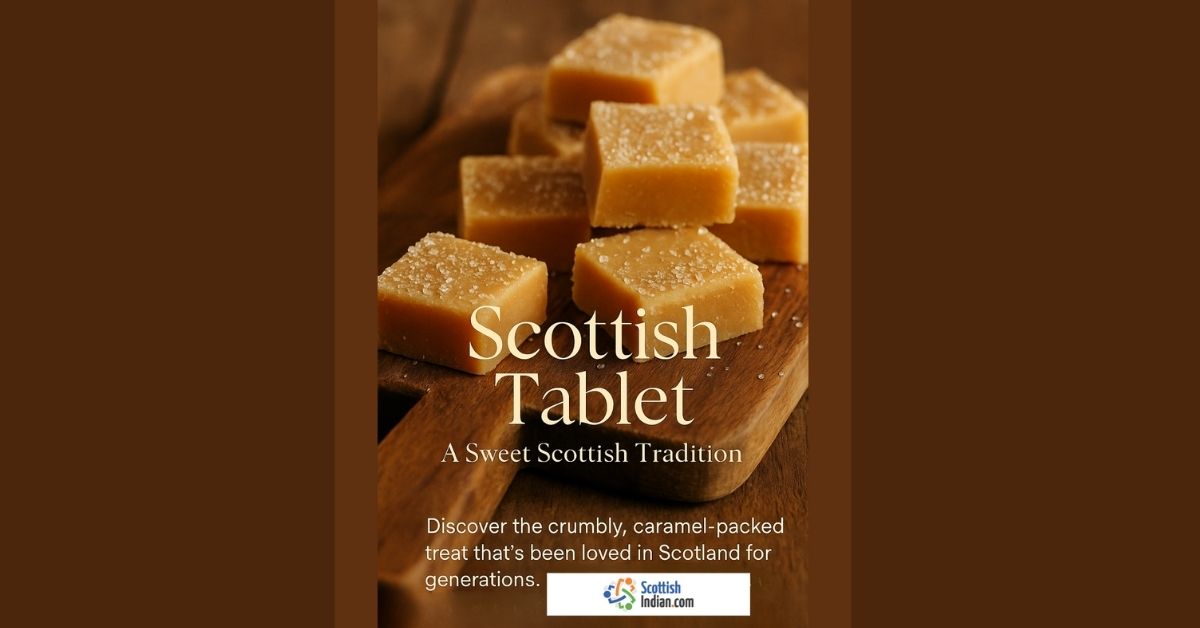Scottish tablet is a grainy, melt‑in‑the‑mouth confection that has delighted generations throughout Scotland and beyond. Often compared to fudge, tablet has its own unique crumbly texture and deep caramel flavor, making it a staple treat for celebrations, teatime indulgences, and thoughtful homemade gifts. In this blog post, we’ll explore the history of tablet, dive into the chemistry that gives it its signature texture, share a classic recipe (with tips for success), and suggest ways to enjoy and customize this beloved sweet.
Dive deeper into the roots of Scottish cuisine in our Scotland Specials post.
A Brief History of Tablet
The origins of tablet date back to the early 19th century, emerging from a landscape of home kitchens and small confectioners experimenting with sugar, cream, and butter. While fudge appears in English cookery from the 1880s, tablet seems to have developed independently in Scotland, perhaps influenced by the availability of dairy and the Scottish penchant for rich, hearty flavors. Traditionally, tablet was cooked in a heavy pot over a hearth fire, stirred by hand until the sugar caramelized and the mixture crystallized just enough to set firmly but not too hard to bite into.
Over time, tablet became woven into Scottish cultural rituals. It featured in ceilidh tea trays, hogmanay celebrations, and as a token gift during Burns suppers. Even today, you’ll find tablet wrapped in cellophane at farmers’ markets, sold in sweetie shops in seaside towns, and lovingly prepared in home kitchens across the Highlands and Lowlands alike.
The magic of tablet lies in its sugar crystallization. Unlike fudge, which is stirred briefly and then cooled slowly to yield a smooth, creamy finish, tablet is boiled to a slightly higher temperature (around 115 °C/240 °F) and beaten until it becomes grainy. This process creates many small sugar crystals that give tablet its characteristic “grain.” Key factors include:
- Sugar-to-Liquid Ratio: Tablet recipes typically call for a 2:1:1 ratio of sugar, whole milk (or condensed milk), and butter.
- Cooking Temperature: Bringing the mixture to “soft‑ball” stage (115 °C) ensures enough concentration for crystallization without turning rock‑hard.
- Cooling & Beating: After reaching temperature, the mixture must cool briefly off‑heat before vigorous beating. This promotes uniform crystal formation.
Explore more of Scotland’s culinary heritage, from sweet treats to fine dining.
Classic Scottish Tablet Recipe
This no‑fail recipe yields a dozen generous squares of tablet. Feel free to double it for larger batches!
Ingredients:
- 900 g (4 cups) granulated sugar
- 395 g (1 can) sweetened condensed milk
- 225 g (1 cup) unsalted butter
- Pinch of salt (optional, to enhance flavor)
Instructions:
- Prepare Your Tin. Line a 20 cm (8‑inch) square baking tin with parchment paper, leaving an overhang for easy removal.
- Melt Butter & Milk. In a heavy‑bottomed saucepan over medium heat, melt butter. Stir in condensed milk until smooth.
- Add the Sugar. Gradually add granulated sugar, stirring constantly to dissolve.
- Boil to Soft‑Ball Stage. Attach a sugar thermometer. Bring mixture to 115 °C (240 °F), stirring gently to prevent scorching.
- Cool Briefly. Remove pan from heat. Allow mixture to cool undisturbed for 5–10 minutes—until the surface “stalls” and becomes glossy.
- Beat to Grain. Using a wooden spoon or electric mixer on low, beat until the mixture thickens, stiffens, and loses its gloss (about 5–8 minutes).
- Set & Slice. Quickly but carefully pour into lined tin, spreading evenly. Leave undisturbed at room temperature for at least 2 hours. Lift out, peel away paper, and cut into squares.
Tips for Success:
- Use a heavy pan with thick walls to distribute heat evenly.
- Don’t skip the cooling pause before beating, or you’ll end up with too‑smooth fudge rather than grainy tablet.
- If sugar crystals form on the sides of your pan early, wet a pastry brush and wash them down to prevent premature crystallization.
While classic tablet is heavenly on its own, here are a few ways to put a modern spin on the tradition:
- Chocolate Tablet: Stir in 100 g of chopped dark chocolate just after beating, then swirl before setting.
- Salt‑and‑Caramel Tablet: Sprinkle flaky sea salt over the surface immediately after pouring into the tin.
- Whisky‑Infused Tablet: Replace 2 tablespoons of milk with a good Scotch; add it off‑heat right before the cooling pause.
- Seed & Nut Tablet: Mix in toasted chopped hazelnuts, almonds, or pumpkin seeds for extra crunch.
A tried‑and‑tested recipe from the BBC, complete with step‑by‑step photos and tips.
Serving, Storing, and Gifting
- Serving: Tablet is best served at room temperature. Pair with strong tea or a smoky single malt for a true Scottish experience.
- Storing: Keep in an airtight container at room temperature for up to two weeks. For longer storage, wrap squares individually and freeze for up to three months.
- Gifting: Line small boxes or tins with parchment, arrange squares in neat rows, and tie with tartan ribbon for a charming homemade gift.
Scottish tablet is more than just a sweet. It’s a delicious link to Scotland’s culinary heritage. Whether you stick to the classic or venture into bold new flavors, each bite brings a taste of tradition and the warm hospitality of the Highlands. Try this Scottish tablet recipe today and share your results with us!






